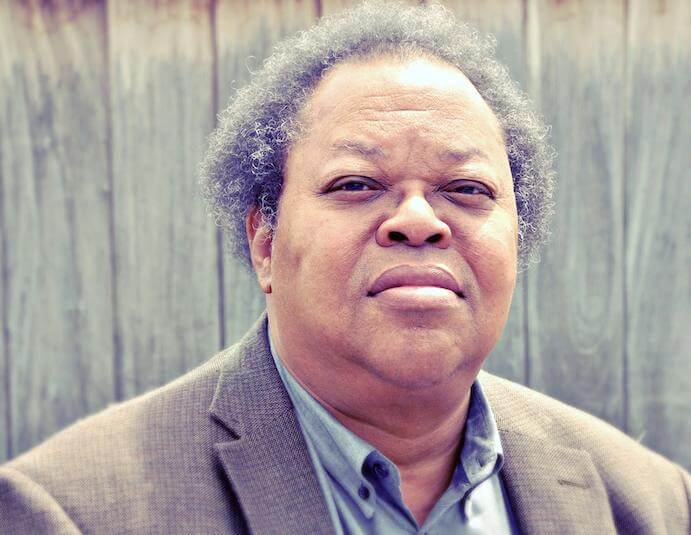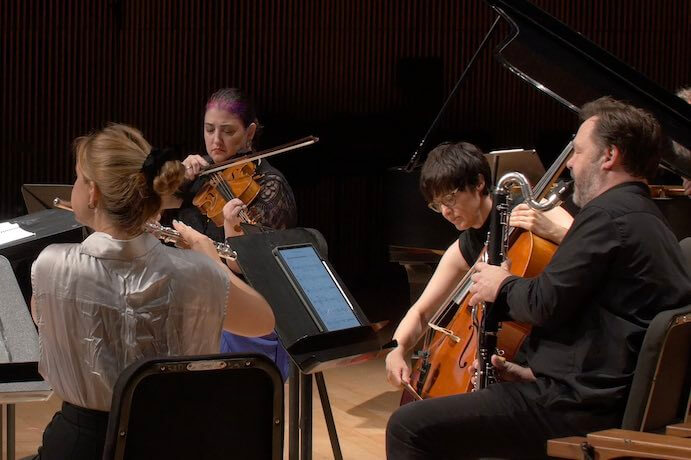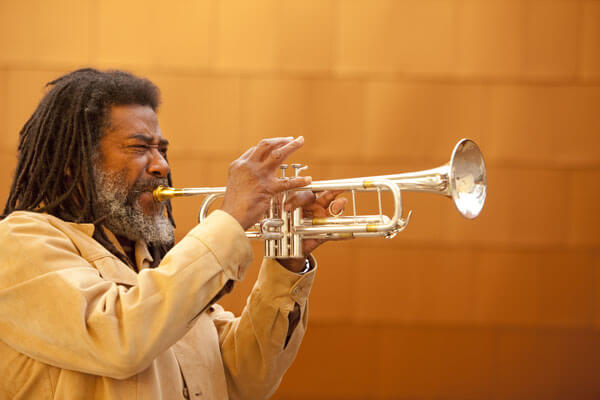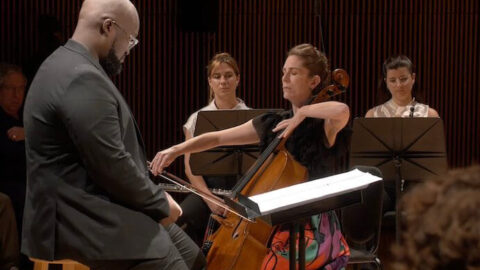As the new artistic director of the International Contemporary Ensemble, George Lewis aspires for the ensemble to be “nothing less than a new consciousness for new music” that embraces the concept of “polyaspora” through “gender, ethnicity, race, musical directions, aesthetics, and geography.” Lewis succeeds co-artistic directors Rebekah Heller, Ross Karre, and Joshua Rubin, who led the ensemble following the departure of Claire Chase, the ensemble’s co-founder and flutist of more than two decades. He was unable to attend the ensemble’s Aug. 25 performance at the 2023 TIME:SPANS festival, but his remarks were read from the stage at the DiMenna Center for Classical Music by the ensemble’s executive director, Jennifer Kessler. During his tenure with the ensemble, Lewis is proposing an intercultural and multigenerational approach to new music, regenerated by “new subjects, histories, and identities.”
While it is exciting to see a group as esteemed as the International Contemporary Ensemble being taken in bold new directions, the breadth and scope of these ambitions will likely take more than one concert to realize. That said, Lewis’ first curated program – which included works by Younghi Pagh-Paan (박영희), Andile Khumalo, Aida Shirazi (آیدا شیرازی), and Wadada Leo Smith, under the excellent direction of Vimbayi Kaziboni – offered promising lines of inquiry into this vision.

The performance opened with Younghi’s Wundgeträumt (“Wound Dreamed”) for flute, oboe, clarinet, violin, viola, and cello. Responding to a poem by Byung-Chul Han (한병철), the composer focuses on the Buddhist concept of cyclical existence or, as she elegantly puts it, “death is a bridge to recurrence.” Younghi coaxes extra-musical sounds from the group and juxtaposes timbres, using pressure and force with intrusive stomps by the ensemble. The piece features sonic cycles that vacillate between compression and deformation, effectively communicating the wandering nature of life, but also precluding resolution. As a result, the piece stops more than it finishes.
Recent violent attacks on migrant Africans from South African citizens inspired Khumalo’s, Invisible Self. It is a complex idea about relational identity that is well-executed through Khumalo’s subversion of traditional form. Though described as a piano concerto (with Jacob Greenberg as an excellent soloist), Khumalo does not give the piano a fully-formed identity. Instead, it operates in an ongoing process of becoming along with the marimba (performed with precision by Clara Warnaar). The initial cacophony creates an environment where each instrument seems to test its boundaries. The piano builds a skeletal identity apprehensively, employing jazz idioms, the bow music of amaxhosa, amadinda (Ugandan xylophone), and Shekere music. Eventually, the piano finds its groove, but it is changed and transformed from its first incarnation.

Shirazi’s Crystalline Trees encouraged deep listening and quiet contemplation. Like Younghi, Shirazi wrote her work in response to a poem. Specifically, she engages the final verses of Mehdi Akhavān-Sāless‘ (مهدی اخوان ثالث) Winter (1956) to lament the darkening political climate of Iran following the U.S.-backed coup of 1953. Shirazi evokes winter soundscapes through the subtle scraping of membranophones and low, muted growls from the woodwinds. Shirazi’s music compels you to appreciate the subtleties of the hushed passages, providing profound emotional resonance to the whistling, melancholic harmonics, which emerge with a fragile beauty.
Smith’s Gondwana: Earth, a Blue Sanctuary was thematically most difficult to reconcile with Lewis’ aspirations. While the other pieces on the program observed the unstable conflicts of identity in a changing world, Smith’s work finds inspiration in the Neoproterozoic era — Gondwana was a supercontinent that existed c. 800–650 million years ago. Here, the subject is migratory, but non-human; the duration of time is geologic and outside our comprehension. Yet, Gondwana, and Smith’s presence at the concert, made the show. After three works that proposed profound metaphorical and symbolic meanings, it was refreshing to hear Smith respond to an inquiry about the work’s inspiration with a laugh, a shrug, and a confession that “I don’t know.”

But Smith didn’t shy away from making a political reading of his work when he noted that Africa will bump into us millions of years from now. It was a sly and subtle reminder that our fiercest attempts to separate ourselves are always bound to fail. To represent this, Smith used three separate ensembles (winds and brass, percussion, and strings, arranged in distinct groups across the stage) that started in unison, broke apart, and came back together again. Simultaneously, the ensembles were indirectly led by the commanding and spirited cello soloist Ashley Walters. But this description suggests too much order; the power of the piece is in its continual shifts in form and mood. The aerophones and the strings vacillate between their tutti sections while a reverberant bass drum punctuates the passing of time. The sound drifts in different directions and suddenly arrives at a tone cluster. The performance was thrilling and frequently delivered the unexpected.
The performance was abundant but unfocused in the best possible way: I prefer too many ideas over too few; I prefer needing to wrestle with a program over being unchallenged. If anything, my unresolved feelings testify to the generative potential of Lewis’ approach, but it also points to the potential issues of such a large undertaking. But the International Contemporary Ensemble has returned this season in good form and with a mission worth following.
I CARE IF YOU LISTEN is an editorially-independent program of the American Composers Forum, and is made possible thanks to generous donor and institutional support. Opinions expressed are solely those of the author and may not represent the views of ICIYL or ACF.
You can support the work of ICIYL with a tax-deductible gift to ACF. For more on ACF, visit the “At ACF” section or composersforum.org.
























